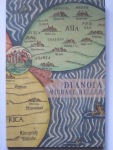
In the closing lines of this attractively produced little piece of history Anthony Barnett refers to Yoko Ono as Eiko and thereby brings back into focus another little fragment of history. Some eight years ago I received an email from Michael Rumaker, Black Mountaineer who had been taught by Olson in the 1950s, in which he commented upon my determination to locate and read his first novel, The Butterfly:
‘You mentioned you plan to read my Butterfly this weekend with an eye to comparing it to Douglas Woolf’s Wall to Wall. I’m glad I have the chance to warn you the comparison will not stand up. Butterfly was my first novel and as with all first novels is riddled with flaws, and in this case, excessive emotion and not as direct as I would have written it in a later time. That, despite its being highly autobiographical, and also perhaps its being of some historical interest, since the character of “Eiko” is actually Yoko Ono (no secret anymore since Albert Goldman wrote about that fact in his 1988 The Lives of John Lennon) and the character of “Alice” is actually Joyce Johnson, former girlfriend of Jack Kerouac who was with him when On the Road hit it big).’
When Barnett’s recent publication was reviewed in The Times Literary Supplement on May 20th J.C. opened his piece with a fine piece of tongue-in-cheekery:
‘There is something appealing about a music memoir that opens “I do not have to tell you how disgraceful John’s attitude was and Yoko’s is”. The author of UnNatural Music is the poet Anthony Barnett who produced the Natural Music concert in Cambridge in 1969…’
The tongue-in-cheekery is of course that Barnett does have to tell us and what he tells is clear and to the point. His historical reconstruction, a past that never simply gets swallowed up in a present, is immaculate and the whole book is presented in a style that over many years Anthony Barnett has made his own: a type of signature publishing dish. Buy a copy NOW!
The historical reconstruction undertaken here is not simply about that concert in 1969; we enter into a spectral world of the past as the book opens with the words ‘For a while from 1965 I worked at Better Books, New Compton Street, round the corner from their Charing Cross Road shop. That section of New Compton Street no longer exists. A redevelopment covers it.’ We are immediately drawn into a world that will include Nothing Doing in London One, ‘which included a music score by John Tchicai’; the letterpress literary and arts loose-leaf folio review also included work by Samuel Beckett and Anne-Marie Albiach. In January 1968 Nothing Doing in London Two appeared with work by George Oppen as well as Yoko Ono’s ‘On Paper’. As Mr Barnett tells me the title page was ‘set in Castellar font, and the names in Plaintin font’. Needless to add that both are now collectors’ items!
Rumaker’s novel opens in a hospital which conveys a haunting sense of the prophetic for Ken Kesey’s later masterpiece, One Flew Over the Cuckoo’s Nest:
‘The low stucco buildings of the hospital with their harsh green windows and heavy wire screening stretched out in all directions as far as the eye could see.’
Anthony Barnett’s magical reconstruction of long gone days comes off the page with similar focus.
Ian Brinton 29th May 2016




